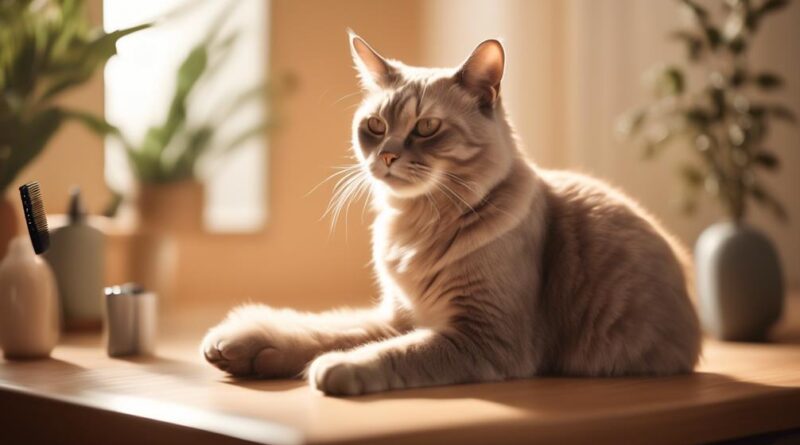Calm Grooming Techniques for Anxious Cats
If you've ever struggled with grooming an anxious cat, you know the challenge it can present. But fear not, there are effective techniques that can help your feline friend feel more at ease during grooming sessions.
From creating the right environment to using gentle brushing techniques, there are several strategies you can employ to make the experience less stressful for your cat.
But what are these techniques, and how can they be implemented in your own grooming routine?
Understanding Cat Anxiety
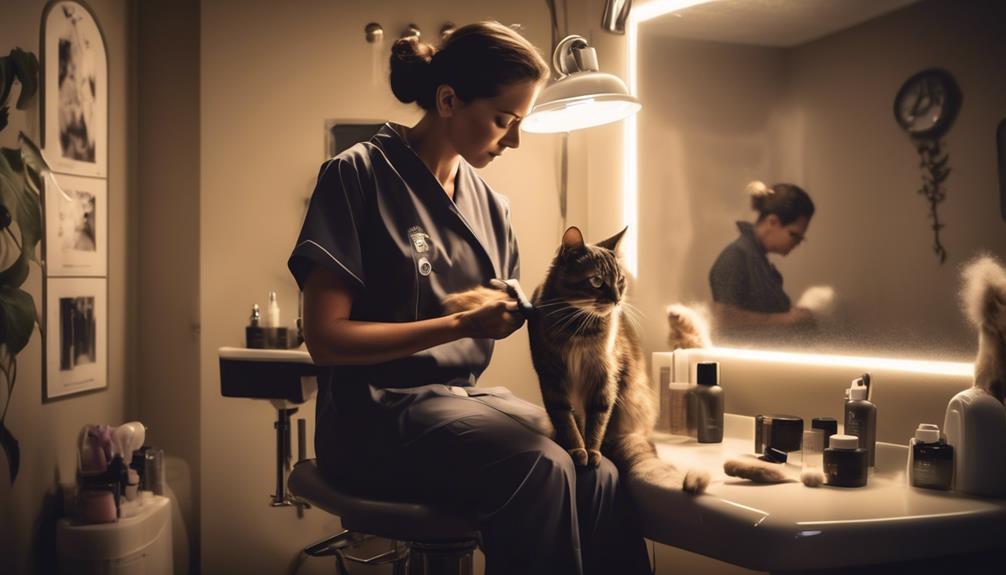
To understand cat anxiety, observe their behavior and body language for signs of stress. Recognizing signs of anxiety in cats is crucial for their well-being. Look for changes in their behavior such as excessive grooming, hiding, aggression, or withdrawal. Cats may also display physical signs like dilated pupils, flattened ears, or a twitching tail. Understanding these signs can help you manage triggers that cause anxiety in your cat.
Managing triggers involves creating a safe and secure environment for your cat. This may include providing hiding spots, vertical space, and interactive toys to help them feel more in control of their surroundings. Additionally, establishing a routine for feeding and playtime can reduce uncertainty and anxiety.
It's important to be mindful of any changes in the environment that could trigger anxiety in your cat. Loud noises, new visitors, or changes in routine can all contribute to feelings of unease in your feline friend. By identifying these triggers, you can take proactive steps to minimize their impact and help your cat feel more at ease.
Setting the Right Environment
Creating a calm and secure environment is essential for helping your anxious cat feel more at ease and comfortable in their surroundings. Here are some tips to set the right environment for grooming your anxious cat:
- Creating a Peaceful Space: Designate a quiet and calm area for grooming. Choose a room where your cat feels most comfortable and safe. Minimize noise and distractions, and consider using soothing music or pheromone diffusers to create a relaxed atmosphere.
- Gentle Handling Techniques: Approach your cat with gentleness and patience. Use slow movements and soft voices to help them feel reassured. Avoid sudden gestures or loud noises that could startle them. Gradually introduce grooming tools and techniques, allowing your cat to become accustomed to them at their own pace.
- Comfortable Resting Spot: Provide a comfortable resting spot for your cat during grooming sessions. Use a soft blanket or cushion in their favorite spot, allowing them to relax and feel at ease. This will help them associate grooming with positive experiences and comfort.
- Proper Lighting: Ensure the grooming area is well-lit but not overly bright. Proper lighting can help you see what you're doing and provide a sense of security for your cat. Avoid harsh, direct light that may cause discomfort or anxiety.
Gentle Brushing Techniques
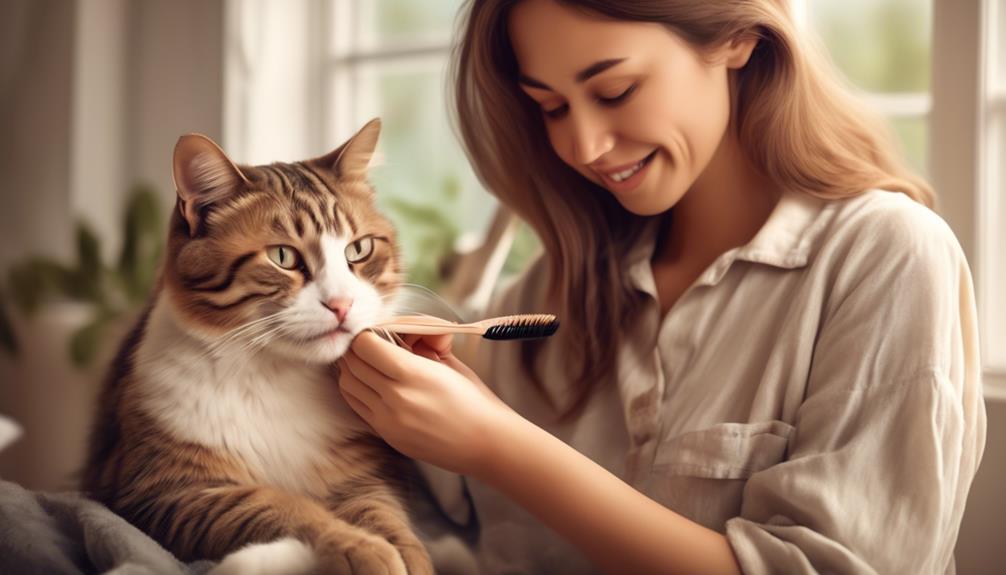
When grooming an anxious cat, start by gently introducing the brush to them in a calm and reassuring manner. Begin by allowing the cat to sniff the brush and become familiar with it. Use slow, deliberate movements to show the cat that the brush isn't a threat. Once the cat seems more at ease, you can start with gentle handling and soothing massage to help them relax. Use slow, smooth strokes, and pay attention to how the cat is responding. If they show signs of discomfort, stop and give them a moment before continuing.
It's important to use a brush specifically designed for cats, such as a soft bristle brush or a grooming glove. These tools are gentle on the cat's skin and help to remove loose fur without causing any discomfort. When brushing, focus on areas where the cat enjoys being touched, such as the cheeks and the base of the ears. This can help to create positive associations with the grooming process.
Remember to be patient and offer plenty of verbal reassurance throughout the grooming session. If the cat becomes too anxious or agitated, it's best to stop and try again later. With time and gentle, consistent grooming, even the most anxious cats can learn to enjoy the experience.
Slow Introduction to Tools
As you familiarize your anxious cat with grooming tools, continue to approach the process gently and reassuringly, building on the trust and relaxation established during gentle brushing techniques. The slow introduction to tools is crucial for helping your cat become comfortable with the grooming process. Here are some important tips for gradually introducing grooming tools to your anxious cat:
- Familiarize Through Scent: Before using a new grooming tool on your cat, allow them to become familiar with it by placing the tool near their resting areas. This allows them to investigate the tool at their own pace and become accustomed to its scent.
- Positive Association: Use treats or their favorite toys to create a positive association with the grooming tools. Show them the tool while giving them a treat, so they start associating the presence of the tool with something pleasant.
- Gradual Touch Introduction: Once your cat seems comfortable with the presence of the grooming tool, gently touch them with it without actually using it for grooming. This helps them get used to the sensation of the tool.
- Short, Positive Sessions: Start with very short grooming sessions using the tool, gradually increasing the duration as your cat becomes more comfortable. Always praise and reward them for good behavior during these sessions.
Calming Pheromone Sprays
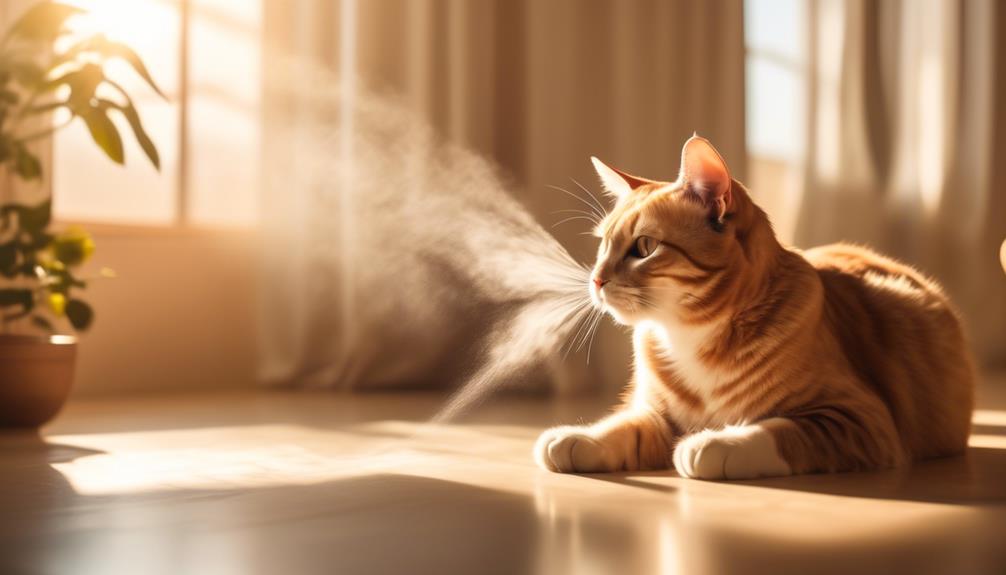
To help ease your anxious cat's grooming experience, consider using a calming pheromone spray to create a soothing environment. Calming pheromone sprays are natural alternatives that can help alleviate stress and anxiety in cats. These sprays work by mimicking the facial pheromones that cats produce when they rub their face against objects in their environment.
When you use a calming pheromone spray, it helps to create a familiar and comforting atmosphere for your cat, making the grooming process less intimidating.
In addition to using calming pheromone sprays, behavioral therapy can also be beneficial for anxious cats. This may involve creating positive associations with grooming through treats, praise, and gentle handling. By gradually introducing grooming tools and techniques while using calming pheromone sprays, you can help your cat become more comfortable with the grooming process over time.
When using calming pheromone sprays, it's important to follow the instructions provided by the manufacturer. Typically, you'll need to spray the product in the areas where your cat spends the most time, such as their bedding, favorite resting spots, and areas where they eat. This helps to ensure that the calming effects of the pheromones are spread throughout your cat's environment.
Positive Reinforcement Methods
Consider incorporating positive reinforcement methods as a way to further enhance your cat's grooming experience, building on the foundation of calmness established through the use of calming pheromone sprays.
When it comes to grooming anxious cats, positive reinforcement methods can make a significant difference in their overall experience. Here are some effective techniques to consider:
- Clicker Training: Utilize clicker training to reinforce positive behaviors during grooming sessions. By associating the sound of the clicker with treats and rewards, you can encourage your cat to remain calm and cooperative.
- Treats: Use high-value treats as a form of positive reinforcement. Reward your cat with treats when they display relaxed behavior during grooming. This will create a positive association with the grooming process.
- Play Therapy: Prior to grooming, engage your cat in interactive play to help release excess energy and reduce anxiety. Play therapy can help your cat feel more relaxed and receptive to grooming activities.
- Desensitization: Gradually introduce grooming tools and activities to your cat in a gentle and controlled manner. By slowly acclimating them to the grooming process, you can help reduce their anxiety over time.
Incorporating these positive reinforcement methods can't only improve your cat's grooming experience but also strengthen the bond between you and your feline companion. By utilizing clicker training, treats, play therapy, and desensitization, you can help your cat feel more at ease during grooming sessions.
Patience and Consistency
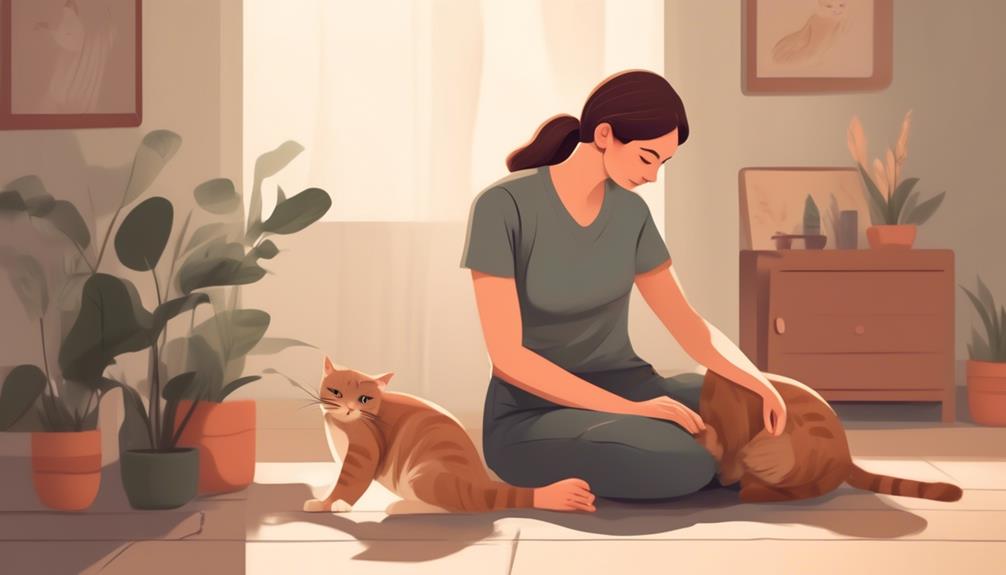
Developing patience and consistently practicing grooming routines will play a crucial role in helping your anxious cat acclimate to the grooming process. Building trust is essential, and this requires a gradual approach. It's important to understand that grooming an anxious cat will take time and effort, but with patience and consistency, you can help your feline friend become more comfortable with the grooming process.
When working with an anxious cat, it's crucial to approach grooming sessions with a calm and patient demeanor. Your cat may initially be hesitant or resistant, so it's essential to take things slow and not force the grooming process. Start by simply spending time near your cat while offering treats and gentle pets. This will help build trust and create a positive association with grooming.
Consistency is key when it comes to grooming an anxious cat. Establish a routine and stick to it, as this will help your cat feel more secure and relaxed during grooming sessions. By consistently practicing grooming techniques, your cat will gradually become more accustomed to the process and may even begin to feel more at ease.
Seeking Professional Help
If your cat's anxiety around grooming persists despite your best efforts, seeking professional help from a veterinarian or a certified feline behaviorist can provide valuable support and guidance. Professional consultation is essential when dealing with persistent grooming-related anxiety in cats.
Here's what you can expect from seeking professional help:
- Comprehensive Evaluation: A professional will conduct a thorough assessment of your cat's behavior and overall health to identify the root cause of their grooming anxiety.
- Customized Behavior Modification Plan: Based on the evaluation, the veterinarian or behaviorist will create a personalized behavior modification plan tailored to your cat's specific needs.
- Medication Options: In some cases, medication may be recommended to help alleviate your cat's anxiety and facilitate a more positive grooming experience.
- Ongoing Support and Monitoring: Professionals will provide ongoing support and guidance as you implement the behavior modification plan, making adjustments as needed and monitoring your cat's progress closely.
Frequently Asked Questions
Can I Use Essential Oils or Other Aromatherapy Methods to Help Calm My Anxious Cat During Grooming?
You can use essential oils or other aromatherapy methods to help calm your anxious cat during grooming. These alternative methods can provide benefits of aromatherapy for cats, but be mindful of potential risks of using essential oils for cats.
Are There Specific Types of Brushes or Grooming Tools That Are Better for Anxious Cats?
When grooming anxious cats, select gentle grooming tools and techniques to ease their anxiety. Use soft brushes and grooming aids designed for sensitive cats. Avoid forceful handling and provide a calm environment to help alleviate their anxiety during grooming.
How Can I Help My Cat Become More Comfortable With Grooming Over Time?
To help your cat become more comfortable with grooming over time, use positive reinforcement and desensitization. Start with gentle handling and gradual exposure to grooming tools. Reward your cat with treats or praise to create a positive association with grooming.
Should I Consider Sedation or Medication for Grooming My Anxious Cat?
You should consider using training methods and positive reinforcement before resorting to sedation or medication for grooming your anxious cat. These techniques can help your cat become more comfortable with grooming over time.
Are There Any Specific Techniques for Grooming Long-Haired or Short-Haired Cats That May Help Reduce Their Anxiety?
When grooming long-haired or short-haired cats, consider grooming frequency and handling techniques. Regular grooming can help reduce anxiety. Use gentle handling and positive reinforcement to create a calm and comfortable grooming experience for your cat.
Conclusion
So, if your cat is feeling anxious, remember to create a calm and safe environment, use gentle grooming techniques, and introduce tools slowly.
Consider using calming pheromone sprays and positive reinforcement to help your cat feel more comfortable.
Be patient and consistent in your approach, and don't hesitate to seek professional help if needed.
With the right techniques and support, you can help your anxious cat feel more relaxed and at ease.
